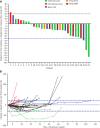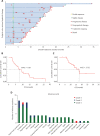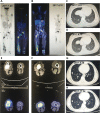Clinical study of apatinib in the treatment of stage IV osteogenic sarcoma after failure of chemotherapy
- PMID: 32587785
- PMCID: PMC7309459
- DOI: 10.20892/j.issn.2095-3941.2019.0397
Clinical study of apatinib in the treatment of stage IV osteogenic sarcoma after failure of chemotherapy
Abstract
Objective: To analyze the efficacy and safety of apatinib in the treatment of stage IV osteogenic sarcoma after chemotherapy failure through a single-arm, prospective, and open clinical phase II study. Methods: Information on 34 patients with stage IV osteogenic sarcoma treated with apatinib after failure of chemotherapy in Tianjin Medical University Cancer Institute and Hospital between September 2015 and December 2019 was collected and analyzed. The participants included 23 males and 11 females, with an average age of 35.24 years (11-73 years). The objective response rate (ORR), disease control rate (DCR), progression-free survival (PFS), PFS rate (PFR), and overall survival (OS) were evaluated. The treatment-related adverse events (AEs) and safety of apatinib were also evaluated. Results: Of the 34 patients, 33 were able to be evaluated for efficacy. One patient received apatinib treatment for less than one cycle; therefore, only safety analysis was performed. The 12-week clinical evaluation showed that 2 patients had a partial response (PR), 24 patients had stable disease (SD), and 7 patients had progressive disease (PD). The ORR, DCR, and PFR at 12 weeks were 6.06% (2/33), 78.79% (26/33), and 82%, respectively. By the end of the follow-up, 6 patients had SD (18.18%, 6/33), 27 patients had PD (81.82%, 27/33), and 15 patients died because of disease progression (45.45%, 15/33). The ORR was 0 (0/33), the DCR was 18.18% (6/33), and the median PFS (mPFS) was 7.89 months (95% CI: 4.56-11.21). The median OS (mOS) was 17.61 months (95% CI: 10.85-24.37). The most common treatment-related AEs were hand-foot syndrome (35.29%, 12/34), proteinuria (32.35%, 11/34), and hypertension (32.35%, 11/34). Conclusions: Apatinib is effective and well tolerated in stage IV osteogenic sarcoma patients after chemotherapy failure.
Keywords: Apatinib; osteogenic sarcoma; progression-free survival; safety.
Copyright: © 2020, Cancer Biology & Medicine.
Figures




Similar articles
-
Efficacy and safety of the VEGFR2 inhibitor Apatinib for metastatic soft tissue sarcoma: Chinese cohort data from NCT03121846.Biomed Pharmacother. 2020 Feb;122:109587. doi: 10.1016/j.biopha.2019.109587. Epub 2019 Nov 28. Biomed Pharmacother. 2020. PMID: 31786466 Clinical Trial.
-
Phase II trial of VEGFR2 inhibitor apatinib for metastatic sarcoma: focus on efficacy and safety.Exp Mol Med. 2019 Feb 28;51(3):1-11. doi: 10.1038/s12276-019-0221-7. Exp Mol Med. 2019. PMID: 30816108 Free PMC article. Clinical Trial.
-
[Retrospective study on the efficacy and safety of low dose apatinib in reversing chemotherapy resistance in sarcoma].Zhonghua Yi Xue Za Zhi. 2022 Aug 23;102(31):2435-2440. doi: 10.3760/cma.j.cn112137-20220106-00039. Zhonghua Yi Xue Za Zhi. 2022. PMID: 36000372 Chinese.
-
The safety of apatinib for the treatment of gastric cancer.Expert Opin Drug Saf. 2018 Nov;17(11):1145-1150. doi: 10.1080/14740338.2018.1535592. Epub 2018 Oct 24. Expert Opin Drug Saf. 2018. PMID: 30324820 Review.
-
Apatinib in recurrent anaplastic meningioma: a retrospective case series and systematic literature review.Cancer Biol Ther. 2020 Jul 2;21(7):583-589. doi: 10.1080/15384047.2020.1740053. Epub 2020 Mar 25. Cancer Biol Ther. 2020. PMID: 32212907 Free PMC article.
Cited by
-
Activity and safety of apatinib monotherapy or apatinib combined with chemotherapy for patients with metastatic or unresectable osteosarcoma over the age of 40 years: A retrospective analysis.Front Oncol. 2022 Nov 1;12:1031787. doi: 10.3389/fonc.2022.1031787. eCollection 2022. Front Oncol. 2022. PMID: 36387068 Free PMC article.
-
Efficacy and safety of apatinib in the treatment of osteosarcoma: a single-arm meta-analysis among Chinese patients.BMC Cancer. 2021 Apr 23;21(1):449. doi: 10.1186/s12885-021-08154-3. BMC Cancer. 2021. PMID: 33892656 Free PMC article.
-
Low-dose apatinib combined with neoadjuvant chemotherapy in the treatment of early-stage triple-negative breast cancer (LANCET): a single-center, single-arm, phase II trial.Ther Adv Med Oncol. 2022 Aug 12;14:17588359221118053. doi: 10.1177/17588359221118053. eCollection 2022. Ther Adv Med Oncol. 2022. PMID: 35983024 Free PMC article.
-
Evaluation of the efficacy and safety of immunotherapy in sarcoma: a two-center study.Front Immunol. 2024 Mar 22;15:1292325. doi: 10.3389/fimmu.2024.1292325. eCollection 2024. Front Immunol. 2024. PMID: 38585276 Free PMC article.
-
Efficacy and safety of anlotinib in patients with unresectable or metastatic bone sarcoma: A retrospective multiple institution study.Cancer Med. 2021 Nov;10(21):7593-7600. doi: 10.1002/cam4.4286. Epub 2021 Sep 26. Cancer Med. 2021. PMID: 34564939 Free PMC article.
References
-
- Siegel RL, Miller KD, Jemal A. Cancer statistics, 2018. CA Cancer J Clin. 2018;68:7–30. - PubMed
-
- Chen W, Zheng R, Baade PD, Zhang S, Zeng H, Bray F, et al. Cancer statistics in china, 2015. CA Cancer J Clin. 2016;66:115–32. - PubMed
-
- Federman N, Bernthal N, Eilber FC, Tap WD. The multidisciplinary management of osteosarcoma. Curr Treat Options Oncol. 2009;10:82–93. - PubMed
-
- Ferrari S, Briccoli A, Mercuri M, Bertoni F, Picci P, Tienghi A, et al. Postrelapse survival in osteosarcoma of the extremities: prognostic factors for long-term survival. J Clin Oncol. 2003;21:710–5. - PubMed
Publication types
MeSH terms
Substances
LinkOut - more resources
Full Text Sources
Medical
Research Materials
